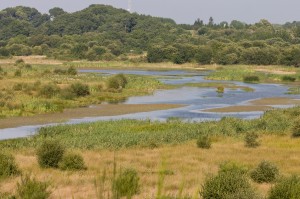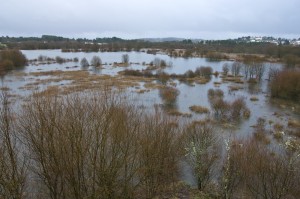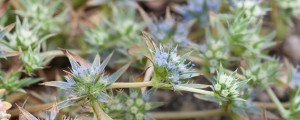Enclave Name: Cospeito Lake.
Protection Categories: Included in the SCI Parga-Ladra-ES1120003 Támoga and the Special Protection Area of Parga-Ladra-Támoga Natural Assets.
Location: It belongs to the municipality of Cospeito province of Lugo.
Region: Galicia
Reference Coordinate: 1Km E2906N2403
Surface of the Wetland: 70 ha
Altitude: 397m
Extensive wetland located in the floodplain of the Guisande River that remains connected by a system of gates built in 1991, eh year in which the restoration of the original wetland ended, which had been desiccated in middle of the last century as a result of the activities of the Agricultural Institute of Colonization.
The Cospeito Lagoon wetland is composed of three major ecologic environments. An environment of stagnant water, represented by two bodies of standing water and a patchwork of temporary ponds. An environment of running water, formed by the Guisande River and small waterways that flow through the wetland. And finally, a semi-terrestrial or hygrphilous environment, encompassing communities with a varying degree of naturalness (woodland and wet scrub, reedbeds , meadows , etc.).
Due to the confluence of rainwater and river inputs, an extensive sheet of shallow water is configured with a high rate of renewal. In the spring and summer period, the contributions of water descend progressively, being exempt surfaces midsummer allows the development of medium-sized herbaceous formations, thus configuring an intricate mosaic where small depressions that keep the sheet of water are inserted until the end of spring period.
The ownership of the wetland corresponds the Xunta de Galicia, who establishes the conservation of environmental assets and the use of public space as the principal uses. The whole wetland is within a Site of Community Importance and Special Protection Area of Parga – Ladra – Támoga Natural assets. Given its conservation interest it is included in this enclave of the Zone “Protection Area” as reflected in the Master Plan for the Natura 2000 network of Galicia.
Cospeito Lagoon is part of the core zone of the Reserve Terras do Miño Biosphere, having an information center for visitors and delimited paths for public use and enjoyment of this place well.
- MORE RELEVANT FEATURES
The environments present in the wetlands of the Cospeito lagoon harbor a great diversity of natural habitats characteristic of wetlands in the Atlantic biogeographic region, eleven of which are considered to be of community interest. Also represented along with these natural habitats are habitats whose origin, configuration and maintenance are directly linked to human activity.
The natural habitats of community interest that reach further extension are included within the group of freshwater habitats, either standing or running, temporary or permanent. Based on these variables and on the trophic level within the wetland up to four types of stagnant freshwater habitats ( 3110 , 3120 , 3130 and 3150 ) and two current freshwater habitats ( 3260 and 3270 ) can be distinguished .
It is precisely in the standing water environments and areas of transition to semi-terrestrial environments where the most important features of wetland, stressing above all a stable population of individuals of Eryngium viviparum Gay, umbelliferous listed in Annex II of the Habitats Directive and are identified as a priority species. Another species of flora listed in Annex II of the Community Directive and present in the wetland, is Luronium natans (L. ) Rafin, an aquatic plant that lives on the edges of ponds and lagoons and backwaters of rivers and in shallow beds.
Habitats of Community Interest
Código Denominación 3110 Aguas oligotróficas con un contenido de minerales muy bajo de las llanuras arenosas (Littorelletalia uniflorae) 3120 Aguas oligotróficas con un contenido de minerales muy bajo sobre suelos generalmente arenosos del mediterráneo occidental con Isoetes spp. 3130 Aguas estancadas, oligotróficas o mesotróficas con vegetación de Littorelletea uniflorae y/o Isoëto-Nanojuncetea 3150 Lagos eutróficos naturales con vegetación Magnopotamion o Hydrocharition 3260 Ríos, de pisos de planicie a montano con vegetación de Ranunculion fluitantis y de Callitricho-Batrachion 3270 Ríos de orillas fangosas con vegetación de Chenopodion rubri p.p. y de Bidention p.p. 4020* Brezales húmedos atlánticos de zonas templadas de Erica cillaris y Erica tetralix 4030 Brezales secos europeos 6410 Prados con molinias sobre sustratos calcáreos, turbosos o arcillo-limónicos (Molinion caeruleae) 6430 Megaforbios eutrofos hidrófilos de las orlas de llanura y de los pisos montano a alpino 6510 Prados pobres de siega de baja altitud (Alopecurus pratensis, Sanguisorba officinalis) 91E0* Bosques aluviales de Alnus glutinosa y Fraxinus excelsior (Alno- Padion, Alnion incanae, Salicion albae) Fauna
In the wetlands of Laguna Cospeito about half a hundred different species of waterfowl can be observed throughout the year, for which it is considered one of the main sites of inner Galicia in the conservation of this fauna group. Standing out for their number is the lapwing (Vanellus Vanellus) or European golden plover (Pluvialis apricaria). Also in the case of lapwing, breeding populations were confirmed in the site. Other species of interest that can be found in this enclave are the Bittern (Botaurus stellaris) or aquatic warbler (Acrocephalus paludicola).Also here the colonies of amphibians can be noted, being among other species of San Antón frog (Hyla arborea) and the Iberian painted frog (Discoglossus galganoi), both species of community interest. Also located in this wetland is the otter (Lutra lutra), a species listed in Annex II and IV of the Habitats Directive.
- PHOTOS




